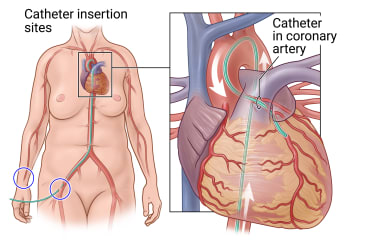Coronary Angiogram With Possible Treatment: Before Your Procedure

What is a coronary angiogram?
A coronary angiogram is a test to look at the blood vessels of your heart. These are called the coronary arteries. You may have this test to see if any of these arteries are narrowed or blocked. The test may also be used to measure the pressure in your heart's chambers. A doctor will put a thin, flexible tube into a blood vessel in your wrist, upper leg or groin. This tube is called a catheter.
During the test, the doctor moves the catheter through the blood vessel and into your heart. Then the doctor puts a dye into the catheter. This makes your coronary arteries show up on a screen. Your doctor can see if the arteries are blocked or narrowed.
If you have a narrowed or blocked artery, the doctor may do an angioplasty or a coronary stent procedure. In an angioplasty, the doctor puts a catheter with a tiny balloon at the tip into the blocked area and inflates it. The balloon presses the fatty buildup (plaque) against the walls of the artery. This makes more room for blood to flow.
In most cases, the doctor then puts a stent in the artery. A stent is a small, expandable tube. It presses against the walls of the artery. The stent is left in the artery to keep it open. This helps blood flow. The catheter is removed from your body.
How do you prepare for the procedure?
Procedures can be stressful. This information will help you understand what you can expect. And it will help you safely prepare for your procedure.
Preparing for the procedure
Be sure you have someone to take you home. Anesthesia and pain medicine will make it unsafe for you to drive or get home on your own.
Understand exactly what procedure is planned, along with the risks, benefits, and other options.
Tell your doctor ALL the medicines and natural health products you take. Some may increase the risk of problems during your procedure. Your doctor will tell you if you should stop taking any of them before the procedure and how soon to do it.
If you take aspirin or some other blood thinner, ask your doctor if you should stop taking it before your procedure. Make sure that you understand exactly what your doctor wants you to do. These medicines increase the risk of bleeding.
Make sure your doctor and the hospital have a copy of your advance care plan. If you don't have one, you may want to prepare one. It lets others know your health care wishes. It's a good thing to have before any type of surgery or procedure.
What happens on the day of the procedure?
Follow the instructions exactly about when to stop eating and drinking, or your procedure may be cancelled. You may be allowed to eat and drink as usual, or you may be instructed to stop eating and drinking. It will depend on your procedure. If your doctor has instructed you to take your medicines on the day of the procedure, please do so using only a sip of water if you were instructed to stop eating and drinking.
Take a bath or shower before you come in for your procedure. Do not apply lotions, perfumes, deodorants, or nail polish.
Do NOT shave the procedure site yourself.
Take off all jewellery and piercings. And take out contact lenses, if you wear them.
At the hospital or surgery centre
Bring a picture ID.
You will be kept comfortable and safe by your anesthesia provider. You may get medicine that relaxes you or puts you in a light sleep. The area being worked on will be numb.
After the procedure, pressure will be applied to the area where the catheter was put into your artery. Then you may have a bandage or a compression device on your groin or arm at the catheter insertion site. This will prevent bleeding.
Nurses will check your heart rate and blood pressure. The nurse also will check the catheter site for bleeding.
If the catheter was put in your groin, you will need to lie still and keep your leg straight for several hours.
If the catheter was put in your arm, you may be able to sit up and get out of bed right away. But you will need to keep your arm still for at least one hour.
You may be able to go home later the same day, or you may need to stay in the hospital overnight.
You may have a bruise where the catheter was put in your groin or arm. This is normal and will go away.
When should you call your doctor?
- You have questions or concerns.
- You don't understand how to prepare for your procedure.
- You become ill before the procedure (such as fever, flu, or a cold).
- You need to reschedule or have changed your mind about having the procedure.
Where can you learn more?
Go to https://www.healthwise.net/patientEd
Enter C330 in the search box to learn more about "Coronary Angiogram With Possible Treatment: Before Your Procedure".
Adaptation Date: 02/28/2022
Adapted By: Alberta Health Services
Adaptation Reviewed By: Alberta Health Services
